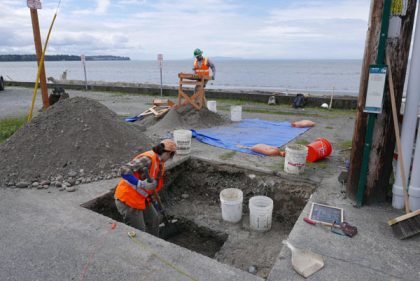By Oliver Lazenby
Traffic could be slow on Birch Bay Drive through Monday, April 24, because a consultant for Whatcom County is digging pits between Cedar Avenue and Lora Lane to examine the soil for cultural artifacts.
The sampling, a necessary review before work begins on the Birch Bay Drive and Pedestrian Facility project (commonly called the berm project), could close one lane of the road on weekdays between 7 a.m. and 5 p.m., and drivers should expect minor delays, according to the Whatcom County Public Works Department.
 Engineers with Environmental Science Associates Inc., a consultant for Whatcom County, probe the first of 14 sample sites. They’re looking for cultural artifacts in the construction area of the planned Birch Bay Drive and Pedestrian Facility, also known as the Birch Bay berm. Photo by Oliver Lazenby.
Engineers with Environmental Science Associates Inc., a consultant for Whatcom County, probe the first of 14 sample sites. They’re looking for cultural artifacts in the construction area of the planned Birch Bay Drive and Pedestrian Facility, also known as the Birch Bay berm. Photo by Oliver Lazenby.
On April 17, the first day of work, Environmental Science Associates Inc. had dug two test pits out of a total of 14 along 1.6 miles of Birch Bay Drive. Once the square pits were cut into the asphalt, both lanes of the road were opened.
Chris Lockwood, principal investigator and geo-archaeologist with Environmental Science Associates, said not all the pits would require blocking traffic. The company is digging pits near the planned location of drainage pipes on the onshore side of the planned sand and gravel berm.
The purpose of the berm project is to restore the natural shoreline in a way that will protect the road from storm damage. It will also include paths, bike lanes and signage to make Birch Bay Drive safer. The county has been working on the project for decades.
Early in the sampling process, Lockwood and others from Environmental Science Associates were sorting through sediment on-site and hadn’t yet found much of interest.
“We found a couple of chicken and cow bones and some shards of glass, which tell us we’re looking at recent fill,” Lockwood said. “The hope is that the project will be avoiding cultural resources.”
Anything of interest will undergo laboratory analysis.
The testing is required as part of the National Environmental Policy Act review process, said Doug Burghart, a Whatcom County Public Works engineer.
Whatcom County did some initial sediment sampling in 2015 and 2016. Jim Karcher, county design and construction manager, told Whatcom County Council’s public works, health and safety committee at a February 21 meeting that the Lummi Nation had requested additional sampling.
Environmental Science Associates’ plan for sampling was approved by several organizations, including Washington State Department of Transportation, the state department of archaeology and historic preservation, and the following tribes: Lummi, Nooksack, Suquamish, Swinomish, Samish, Sauk-Suiattle
and Tulalip.
The Lummi and Nooksack are taking the lead for cultural resources issues for the project, Burghart said.
The archaeological sampling is one item on a dwindling list of steps to complete before construction on the berm starts this September. Another major hurdle is acquiring easements. The county must obtain temporary construction easements and permanent easements from property owners along the length of the project. So far, it has easements for 22 out of 40 properties (6,000 out of 8,300 linear feet),
Burghart said.
Comments
No comments on this item Please log in to comment by clicking here